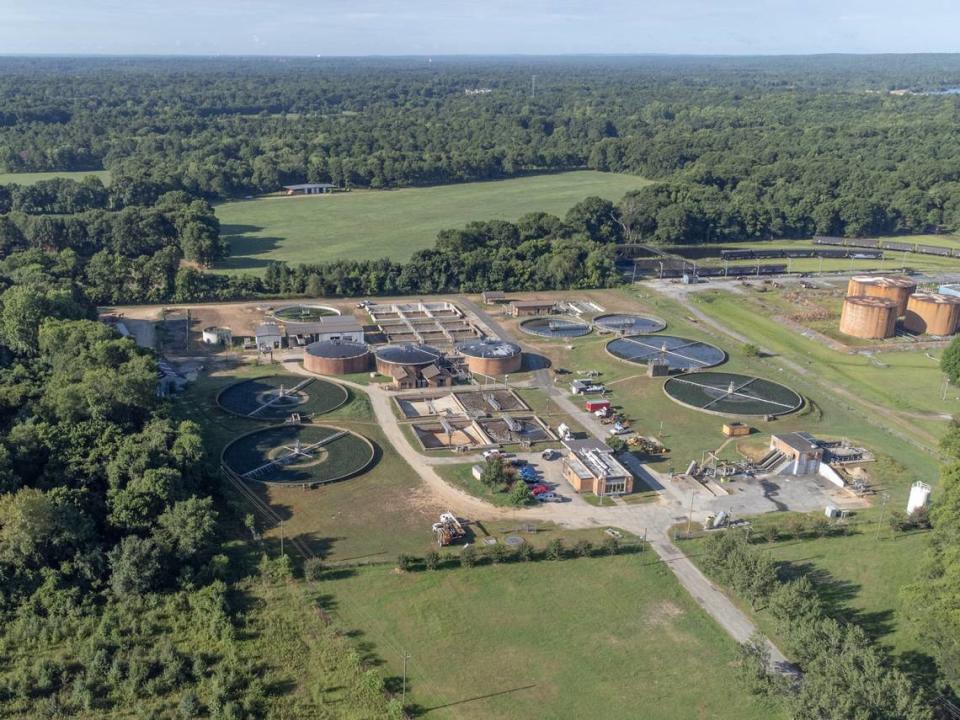Chattahoochee Riverkeeper gives notice to sue Phenix City for failing wastewater plant
The clock is ticking for the Phenix City Water Treatment Plant to fix its infrastructure, which is leading to a higher volume of pollution in the river, before the city could get sued.
After toilets flush and kitchen sinks distribute wastewater from thousands of homes and businesses in Phenix City, the water ends up at the wastewater treatment plant. It is then treated and flows into the Chattahoochee River.
The Clean Water Act and the operation permit by the Alabama Department of Environment (the National Pollutant Discharge Elimination System Permit) require the plant to remove a certain amount of things such as ammonia, suspended solids, and bacteria or E.coli.
However, the plant’s infrastructure has been failing for years, which results in a river filled with millions of gallons of improperly treated wastewater that violates the permits and pollutes the river.
“Recreators throughout the Chattahoochee River Basin should be guaranteed the right to swim, paddle, and fish on clean waterways,” Jason Ulseth, CRK’s executive director said in a press release. “The pollution entering the river from the Phenix City Wastewater Treatment Plant violates that right, and the facility must work to resolve its operational failures before further harm is done to the river and those who depend on it.”
The ADEM previously gave notice to the Phenix City utility department that it was violating a pollution discharge permit on Dec. 19, according to a copy of the permit provided to the Ledger-Enquirer by Chattahoochee Riverkeeper. That’s why the watchdog group has done periodic testing in the area.
Additionally, Chattahoochee Riverkeeper began hearing reports of discoloration in the water from the public.
Since the October of 2023 and until June the levels were “through the roof”, according to the Executive Director of the Chattahoochee Riverkeeper, Jason UIseth. Last month it recorded 17,000 MPN. The permit allows for 126 MPN.
On Tuesday, July 16, the Riverkeeper told the Phenix City Department of Public Utilities it has 60 days to stop discharging illegal levels of pollution into the river or the group would file a lawsuit in federal court for violating the federal Clean Water Act and the Alabama Water pollution Control Act.
A 60-day notice of Intent to Sue is required under the Clean Water Act, according to the press release by the Chattahoochee Riverkeeper. Chattahoochee Riverkeeper is represented by the law firm Smith, Gambrell & Russell, CRK is prepared to file a lawsuit against Phenix City if conditions at the plant fail to improve within 60 days.
The Riverkeeper recently filed a similar notice to Atalanta’s Department of Watershed Management for ongoing pollution violations from the R.M. Clayton Water Reclamation Center earlier this month.

“We are hopeful that we can come to a resolution within the 60 days,” Henry Jacobs, Deputy Director of the Chattahoochee Riverkeper said. “The whole purpose (of the lawsuit) is to have a dialogue with the city and understand how they are going to fix this as soon as possible.”
Jacobs and his team are looking for a detailed plan about how Phenix City is going to take this seriously and resolve the issue.
Phenix City utility manager John Spraggins told the Ledger-Enquirer that three of the four pollutants have all lowered since May.
Spraggins said the total suspended solids limit is 30mg/L and the monthly samples the City gathered were as follows: May 97mg/L, June 43.97 mg/L, July 43.97mg/L.

“We’re continuing to do what we’ve been doing,” Spraggins said. “We’ve done a lot of work with the plant. We’re currently working on the primary clarifiers – a big tank that helps collect a lot of the solids that come into the plant.”
Spraggins and Chab Gamble, assistant city manager and an attorney for the city of Phenix City said there isn’t a way to speed this process up and they are waiting on parts.
“There isn’t a way to speed things up,” Spraggins said. “Manufacturing of the parts dictates the speed. We’re working with a contractor to get started on the clarifier construction.”
Gamble added that he thinks the majority of the pollutants, E.coli, total suspended solids, oxygen levels, will be at the permitted levels by the 60 days, but the ammonia will take longer because it relies on the clarifier.
Ammonia is a form of nitrogen and is a nutrient, according to Ulseth.
“Excessive nutrients promote the growth of invasive species in the river downstream of the discharge pipe,” Ulseth said in an email.
E.Coli is a harmful bacteria that can cause rashes, nausea, or hospitalization if consumed. The Chattahoochee Riverkeeper urges everyone to exercise caution anywhere downstream of the plant outfall.
Phenix City spent $14.6 million dollars in 2022 to improve the facility, and another $439,000 this year, according to a June 6 news release. Spraggins suggested the repairs and construction are what caused the excessive violations in the past six months.
“In February the Riverkeeper staff met with the City,” Jacobs said, “and we had a good conversation and we felt hopeful they were on the right track. They gave us some assurances but between February and July what we saw did not give us confidence that they were moving fast enough and taking it seriously.”

